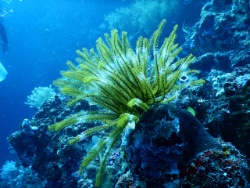Fact Sheet: Marine National Monuments
Fact Sheet: Marine National Monuments
President Bush Discusses Conservation and the Environment
In Focus: Environment
Today, President Bush designated three areas of the Pacific Ocean as marine national monuments. By designating these areas as national monuments, the Administration ensures that the marine environment will receive the highest level of environmental recognition and conservation. Destruction or extraction of protected resources within the boundaries of these monuments will be prohibited, as will commercial fishing in the coral reef ecosystem areas of the monuments. Scientific and recreational activities may be permitted consistent with the care and management of the protected resources of these monuments. For marine life and seabirds, these places will be sanctuaries to grow and thrive.
• Combined,
these designations represent the largest fully protected
area in the world. Under the President's plan, 195,274
square miles will be conserved.
1. The Marianas
Trench Marine National Monument consists of three
components:
2.
• The first component of
this monument is the waters and submerged lands encompassing
the coral reef ecosystem of the three northernmost
islands. These islands represent some of the
westernmost territory in the United States – 5,600 miles
from California. They are home to more than 300 species of
stony corals.
•
• The second component is
the Marianas Trench. The trench, the site of the
deepest place on Earth, is approximately 940 nautical miles
long and 38 nautical miles wide within the Exclusive
Economic Zone of the United States.
•
• The
third component is a series of active undersea volcanoes and
thermal vents. Twenty-one active hydrothermal submarine
volcanoes and vents support life in the harshest conditions
imaginable. Many scientists believe extreme conditions like
these could have been the first incubators of life on Earth.
Further research will allow us to learn more about life on
the bottom of the sea.
3. The Pacific Remote Islands
Marine National Monuments protects the pristine coral reef
ecosystems around Kingman Reef, Palmyra Atoll, Howland,
Baker, and Jarvis Islands, Johnston Atoll, and Wake Island
– the site of a pivotal battle in World War II and an
important military base today. These areas support a
large number of nesting seabirds and migratory shorebirds,
and their pristine coral reefs contain hundreds of thriving
fish species and large apex predators and are also home to
endangered turtles.
4. The Rose Atoll Marine
National Monument protects the pristine coral reef ecosystem
around a remote part of American Samoa. One of its most
striking features is the pink hue of fringing reef caused by
the dominance of reef building coralline algae. Rare
species of nesting petrel, shearwaters, and terns also
thrive on this island, and the waters surrounding it are a
home for many species depleted elsewhere in the world,
including giant clams and reef sharks.
5. The
President also announced America's first new UNESCO World
Heritage Site nominations in 15 years. The two sites
are the Papahanaumokuakea Marine National Monument (in the
Northwestern Hawaiian Islands) and Mount Vernon. Only two
sites can be nominated each year.
In designating the marine areas, the President made explicit that nothing in the proclamations impairs or otherwise affects the activities of the U.S. Department of Defense (DoD). Among other things, the DoD is ensured full freedom of navigation in accordance with the law of the sea, and the U.S. Navy can continue effective training to maintain its antisubmarine warfare and other capabilities.
ENDS


 Global Jews for Palestine: Jewish Organisations' Passover Statement, After 40 Days Of Starvation
Global Jews for Palestine: Jewish Organisations' Passover Statement, After 40 Days Of Starvation APEC: Stronger Immunization Policies Needed As Vaccine Confidence Falls
APEC: Stronger Immunization Policies Needed As Vaccine Confidence Falls 350.org: Indigenous Groups From The Pacific, Brazil & Canada Hand Demands To COP30 Presidency To End Fossil Fuels
350.org: Indigenous Groups From The Pacific, Brazil & Canada Hand Demands To COP30 Presidency To End Fossil Fuels Conservation International: Conservation International Expedition Reveals Ecosystem Recovery In Tokelau
Conservation International: Conservation International Expedition Reveals Ecosystem Recovery In Tokelau UN Special Procedures - Human Rights: UN Expert Urges States To Finance Inclusive And Sustainable Development, Not A War Economy
UN Special Procedures - Human Rights: UN Expert Urges States To Finance Inclusive And Sustainable Development, Not A War Economy Amnesty International Aotearoa NZ: Global - Recorded Executions Highest Since 2015
Amnesty International Aotearoa NZ: Global - Recorded Executions Highest Since 2015